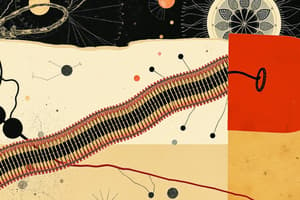Podcast
Questions and Answers
Which organelle is responsible for storing genetic information?
Which organelle is responsible for storing genetic information?
- Rough Endoplasmic Reticulum
- Golgi Body
- Nucleus (correct)
- Mitochondria
What is the primary function of the Golgi Body?
What is the primary function of the Golgi Body?
- makes energy
- sorts and ships proteins (correct)
- detoxifies the cell
- makes proteins
Which organelle is commonly referred to as the 'powerhouse of the cell'?
Which organelle is commonly referred to as the 'powerhouse of the cell'?
- Golgi Body
- Nucleus
- Rough Endoplasmic Reticulum
- Mitochondria (correct)
What is the main function of the cell membrane?
What is the main function of the cell membrane?
Which organelle is responsible for making proteins?
Which organelle is responsible for making proteins?
What is the function of the Smooth Endoplasmic Reticulum?
What is the function of the Smooth Endoplasmic Reticulum?
Which organelle is found in all cell types?
Which organelle is found in all cell types?
What is the function of the Nucleolus?
What is the function of the Nucleolus?
Which organelle makes food during photosynthesis in plant cells?
Which organelle makes food during photosynthesis in plant cells?
What is the primary function of the coarse adjustment knob in a microscope?
What is the primary function of the coarse adjustment knob in a microscope?
Which organelle is responsible for storing water and nutrients in eukaryotic cells?
Which organelle is responsible for storing water and nutrients in eukaryotic cells?
What is the function of the revolving nosepiece in a microscope?
What is the function of the revolving nosepiece in a microscope?
What is the hierarchical order of organization in living organisms?
What is the hierarchical order of organization in living organisms?
Which part of the microscope holds the slide in place on the stage?
Which part of the microscope holds the slide in place on the stage?
What is the correct order of the structure of life?
What is the correct order of the structure of life?
What is the function of the diaphragm in a microscope?
What is the function of the diaphragm in a microscope?
Which of the following is a characteristic of prokaryotic cells?
Which of the following is a characteristic of prokaryotic cells?
What is the formula for calculating the size of cells?
What is the formula for calculating the size of cells?
What is the function of eukaryotic cells?
What is the function of eukaryotic cells?
What is the primary difference between prokaryotic and eukaryotic cells?
What is the primary difference between prokaryotic and eukaryotic cells?
Which type of cell has a cell wall?
Which type of cell has a cell wall?
What is the method of reproduction for prokaryotic cells?
What is the method of reproduction for prokaryotic cells?
What is the function of organelles in eukaryotic cells?
What is the function of organelles in eukaryotic cells?
What is the unit of measurement for cell size?
What is the unit of measurement for cell size?
Which type of cell has a true nucleus?
Which type of cell has a true nucleus?
Flashcards are hidden until you start studying
Study Notes
Cells: Structure and Function
- Cells are the basic units of life, composed of atoms, molecules, organelles, and cytoplasm, and are organized into tissues, organs, organ systems, and organisms.
Characteristics of Life
- Cells exhibit characteristics of life, including growth, metabolism, reproduction, response to stimuli, and evolution.
Types of Cells
- Prokaryotic cells lack a nucleus and cell membrane, but have genetic material (DNA) and cytoplasm.
- Eukaryotic cells have a nucleus, cell membrane, cytoplasm, and genetic material (DNA).
- Plant cells have a cell wall, chloroplasts, and a large vacuole for storage.
- Animal cells have lysosomes for digestion and a centriole for cell division.
Cell Organelles and Their Functions
- Nucleus: stores genetic information/DNA.
- Nucleolus: makes ribosomes.
- Cytoplasm: contains cell contents and acts as a floor for organelles.
- Ribosomes: make proteins.
- Golgi Body: sorts and ships proteins.
- Rough Endoplasmic Reticulum: makes proteins for the endomembrane system.
- Smooth Endoplasmic Reticulum: detoxifies the cell and makes lipids.
- Mitochondria: makes energy ("powerhouse of the cell").
- Cell Membrane: a thin barrier separating the cell from its environment.
- Cell Wall: a rigid barrier protecting the cell (found in plants and prokaryotes).
- Chloroplast: makes food during photosynthesis (found in plants).
- Vacuole: stores water and nutrients.
Microscope Components and Functions
- Revolving Nosepiece (Turret): holds objective lenses and can be rotated to switch between different magnification lenses.
- Coarse Adjustment Knob: responsible for finding the image on the stage and getting the image quickly into focus.
- Diaphragm (or Iris Diaphragm): controls the amount of light that reaches the specimen, adjusting for best illumination.
- Stage Clips: hold the slide in place on the stage to ensure it does not move while observing the specimen.
DNA and RNA
- Deoxyribonucleic Acid (DNA): genetic material containing instructions for cell growth and function.
- Ribonucleic Acid (RNA): involved in protein synthesis and other cellular processes.
Organ Systems
- A group of organs working together to perform complex functions necessary for the survival of the organism.
Studying That Suits You
Use AI to generate personalized quizzes and flashcards to suit your learning preferences.




